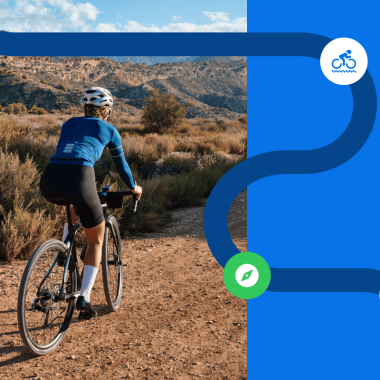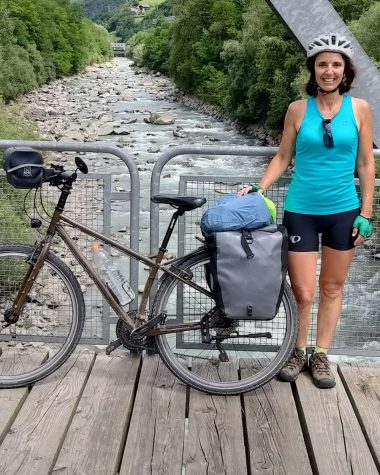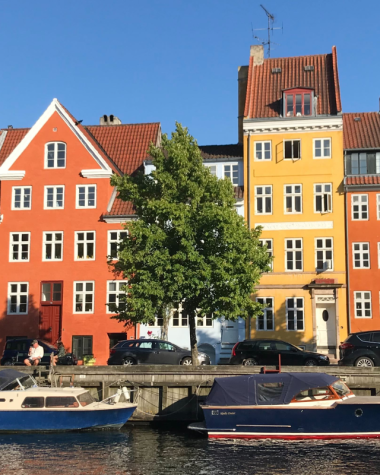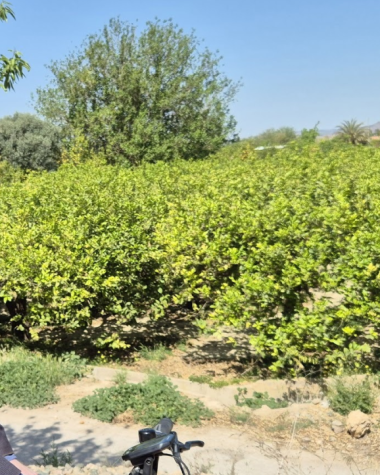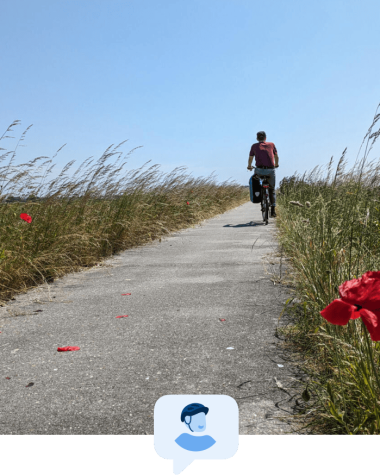Written by Rolf Spethmann
Bikemap user Rolf embarks on an extensive solo bike tour every year. Many months of careful planning and excited anticipation precedes his trips. We’re thrilled that he agreed to share one of his favourite tours with us: a few summers ago he cycled across Germany, starting in the south at Freiburg im Breisgau and finishing in Großenwiehe in the north. On his journey, he visited numerous historic cities, explored the beautiful landscapes of the “German Green Belt” and the Danube river and clocked just under 1500 kilometres in 17 days. Although this was close to home for him, the trip turned out to be no less rewarding than if he had ventured further afield.
You can find Rolf’s complete route on Bikemap here.
🚴 Distance: 1495km
⛰️ Elevation: 3150m
🚲 Road conditions: Along rivers and canals, mostly gravel, but in good quality. Roads and cycling paths in general are in excellent condition.
☀️ Weather: Lovely June with 20-30°C, southwest wind
🗓️ Duration: 17 cycling days
Itinerary
At 5:30 a.m., find me at the train station in Freiburg, happily loading my luggage onto my bike. I’m about to embark on a new tour and in good spirits, full of excitement for the freedom that awaits me. The lion’s share of the route would follow rivers and canals. About halfway to the destination, I would roughly follow the former inner-German border or Iron Curtain, known today as the “green belt” (“Grünes Band” in German).
Starting my tour in Freiburg, the first challenge was to ride through the Black Forest – 33 kilometres with some crisp ascents. My reward was a relaxed ride down to the Danube, which I followed to Weltenburg. I enjoyed the last kilometres along the Danube Gorge on the ferry as the overland route through the woods is plagued by mosquitoes during the summer months. From Kelheim onwards, I continued north following the Altmühl river, the Main-Danube canal, the Rednitz, Regnitz and Itz rivers until I reached Seßlach.
Shortly behind Seßlach, I cycled along the border between Bavaria and Thuringia, mostly following the border bike path called the “green belt”. The road meandered up and down through the vast Rhön region. Having reached the picturesque Werra bike path, I continued northwards on flat terrain. Several intense ascents awaited around the Harz, but afterwards, the landscape would remain flat. Following the Mittelland canal, the Elbe side canal and the Elbe river, I finally reached the port of Hamburg and the Baltic Sea. On my way through Schleswig-Holstein, I was able to admire the ships on the Kiel canal up close one last time before concluding my tour close to the Danish border.

Stages
I would either camp in my tent or book accommodation, depending on the weather. You can probably find a place to stay after arriving at your destination. However, it’s more relaxed to book ahead while on the road (provided you know how far you’d like to cycle that day).
Stage 0 – Freiburg. Arrival by train
Stage 1 – Tuttlingen via Black forest, Danube
Stage 2 – Altheim – Danube
Stage 3 – Günzburg – Danube
Stage 4 – Ingolstadt – Danube
Stage 5 – Beilngries via Danube – Altmühltal
Stage 6 – Erlangen via Main-Danube-Canal – Rednitz – Regnitz
Stage 7 – Seßlach via Main-Danube-Canal – Itz
Stage 8 – Fladungen – “Green belt” (Rhön)
Stage 9 – Probsteizella via Ulster – Werra
Stage 10 – Health spa Heiligenstadt via Werra – Leine
Stage 11 – Clausthal-Zellerfeld – Harz
Stage 12 – Wolfenbüttel – along the former border
Stage 13 – Wittingen via Mittellandkanal / Elbe side canal
Stage 14 – Lüneburg – Elbe side canal
Stage 15 –Hamburg Rissen via Ilmenau – Elbe
Stage 16 – Albersdorf via Elbe – Kiel Canal (NOK)
Stage 17 – Großenwiehe

Equipment, food, weather and expenses
My bike was a Stevens Cyclocrosser (2×11 gears), perfect for this tour. I packed two bags and the tent on the bike’s rear rack and carried a roll-up bag and my sleeping bag in the front. My bike was in good condition and I encountered no problems en route, not even a flat tyre. I find that people are usually open-minded and eager to chat when you’re touring solo, so it’s easy to make conversation whenever you feel like it.
Accessing food isn’t really a problem in Germany. There were plenty of supermarkets either along the route or easily accessible on a small detour. The only notable exception on this route was along the “green belt” between Seßlach and Fladungen, where there weren’t any supermarkets to be found for 90 kilometres. June 2019 was perfect for cycling, there was little rain, temperatures stayed between 20 and 30°C and the south-west wind was comfortable for cycling. The most beautiful moments on the tour were early in the morning by the riverside – when the fog rose, it was quiet and I was alone in nature.
The costs for the tour were moderate. The cheapest campsite in Tuttlingen cost me a total of €5 for a night, but €12-20 for a single person with a tent was standard. Accommodation in hotels, guesthouses or inns ranged from €50 to €70 for a single room, many of them included breakfast. Not counting accommodation, I spent about €450 in total, including the train ride in first class including my bike to get to Freiburg. I expect prices to have increased accordingly in the last five years.

POIs – Places of interest along the tour
I’d like to mention that I avoid visiting bigger cities during the day on my bike journeys. If I want to explore a city, I aim to finish the day’s cycling there so I can visit leisurely in the afternoon or evening.
Freiburg im Breisgau… very bike-friendly, pleasant climate and a beautiful urban centre.
Sigmaringen… the city, the castle and the tranquility at the shore of the Danube.
Ulm… I particularly enjoyed the path from the river past the city walls to the Ulm Minster, the world’s highest church tower.
Nuremberg… the old town is well worth seeing, including a creepy hangman’s house, old bridges, wells and hearty food within the old city walls.
Bamberg… stay a while in a UNESCO World Heritage site (see image below).
Wolfenbüttel… gorgeous old town with a newly restored palace square.
Lüneburg… learn about the development of a village into a city rich in salt, all thanks to a wild boar, which is still honoured today. Beautiful old town with flair.
Hamburg… stunning harbour city. Here, you can find anything your heart desires and more.

These were my personal highlights
The Danube sinkhole at Immendingen… after a dry period, the Danube disappears entirely in the riverbed at Immendingen. The water resurfaces 12 kilometres further down where it feeds into the Aach spring and finally in Lake Constance. Tributaries ensure the preservation of the Danube at this point.
Danube gorge at Weltenburg (Kelheim) followed by the Altmühltal cycle path. Definitely one of Germany’s most picturesque cycle paths.
Seßlach… a small upper Franconian municipality surrounded by a city wall with gates. it feels like entering a historic movie set. Traditionally, beer is very cheap here.
Green belt… after the fall of the inner-German border in 1989, the former Iron curtain became a nature conservation project called the “green belt”. A sign-posted cycle path, 1400km long, now runs through the former death strip.
Monte Kali… in Philippsthal. The dirty white coloured mountain next to the Werra river looks surreal. It gets its appearance from the byproduct of potassium salt production.
Harz… my route crossing the Harz from Osterode to Goslar is very doable by bike. The ascent on the road above Lerbach is not very busy and is the shortest route through the Harz mountains. Alternative routes over the Söse dam and the Oker dam are also very beautiful.
Elbe side canal… beautiful cycling on gravel roads beside the canal. The ship hoist at Lüneberg is especially well worth seeing.
Old Elbtunnel in Hamburg… the 426 metre long old Elbtunnel connects the landing bridges with the port area in Steinwerder. The east tunnel has been elaborately restored and is a must-see.
Landing bridges / Övelgönne… simply watch the goings on and enjoy the flair of the Elbe river and its many ships.
Blankenese… with its quirky stairs quarter and the old captain’s houses.
Kiel canal… the 100 kilometre long Kiel canal (NOK) is one of the busiest artificial waterways in the world, connecting the Baltic Sea and the North Sea. The roads on both sides are perfect for cycling.

Want to discover more?
Read about Rolf Spethmann’s other trips on his cycling blog (in German).
Or discover many more beautiful routes in Germany on Bikemap!


